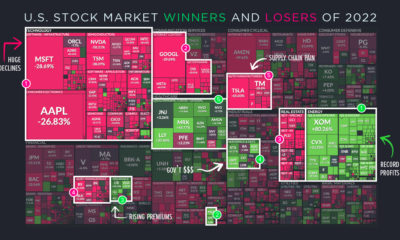This is a record-breaking level of inflows, which raises the question: what are investors buying? To find out, we’ve visualized the 10 most popular picks of 2023, as of February 15.
The Top 10 List
Most of the names in this list won’t come as a surprise. They represent eight of the world’s largest and most well-known tech companies, as well as two highly popular U.S. equity ETFs. Looking closer at the numbers, we can see that Tesla’s net retail flows of $9.75 billion are greater than all of the other individual stocks combined ($8.5 billion). This is a sign that investors still have plenty of faith in Tesla, even as its market share is beginning to shrink. We recently covered Tesla’s profit margins (net profits per vehicle) in a separate infographic. Perhaps the least common name on a top 10 ranking such as this is AMD. The chipmaker has made for a compelling underdog story in recent years, gaining significant market share from its long time rival, Intel.
What About the Meme Stocks?
Several meme stocks made it into the broader top 100 list. This includes Bed Bath & Beyond, which ranked 47th with $114 million in net retail flows. The retailer has been struggling to avoid bankruptcy, recently raising $225 million through an underwritten public offering of preferred shares. A further $800 million could be coming, if certain conditions are met. The company says it’s committed to paying down its overdue debts, and will be closing stores to reduce costs. AMC Entertainment, which saw extreme volatility during the COVID-19 pandemic, ranked 52nd on the list for retail investors with $90 million in net flows. The stock has generated a 27% return YTD (as of Feb. 15). The cinema operator’s revenues have been recovering since the pandemic, but they’ve yet to reach pre-2020 levels. on Last year, stock and bond returns tumbled after the Federal Reserve hiked interest rates at the fastest speed in 40 years. It was the first time in decades that both asset classes posted negative annual investment returns in tandem. Over four decades, this has happened 2.4% of the time across any 12-month rolling period. To look at how various stock and bond asset allocations have performed over history—and their broader correlations—the above graphic charts their best, worst, and average returns, using data from Vanguard.
How Has Asset Allocation Impacted Returns?
Based on data between 1926 and 2019, the table below looks at the spectrum of market returns of different asset allocations:
We can see that a portfolio made entirely of stocks returned 10.3% on average, the highest across all asset allocations. Of course, this came with wider return variance, hitting an annual low of -43% and a high of 54%.
A traditional 60/40 portfolio—which has lost its luster in recent years as low interest rates have led to lower bond returns—saw an average historical return of 8.8%. As interest rates have climbed in recent years, this may widen its appeal once again as bond returns may rise.
Meanwhile, a 100% bond portfolio averaged 5.3% in annual returns over the period. Bonds typically serve as a hedge against portfolio losses thanks to their typically negative historical correlation to stocks.
A Closer Look at Historical Correlations
To understand how 2022 was an outlier in terms of asset correlations we can look at the graphic below:
The last time stocks and bonds moved together in a negative direction was in 1969. At the time, inflation was accelerating and the Fed was hiking interest rates to cool rising costs. In fact, historically, when inflation surges, stocks and bonds have often moved in similar directions. Underscoring this divergence is real interest rate volatility. When real interest rates are a driving force in the market, as we have seen in the last year, it hurts both stock and bond returns. This is because higher interest rates can reduce the future cash flows of these investments. Adding another layer is the level of risk appetite among investors. When the economic outlook is uncertain and interest rate volatility is high, investors are more likely to take risk off their portfolios and demand higher returns for taking on higher risk. This can push down equity and bond prices. On the other hand, if the economic outlook is positive, investors may be willing to take on more risk, in turn potentially boosting equity prices.
Current Investment Returns in Context
Today, financial markets are seeing sharp swings as the ripple effects of higher interest rates are sinking in. For investors, historical data provides insight on long-term asset allocation trends. Over the last century, cycles of high interest rates have come and gone. Both equity and bond investment returns have been resilient for investors who stay the course.













